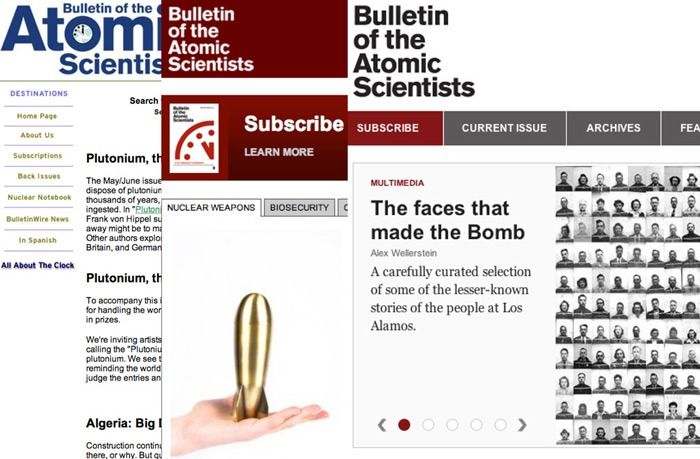A redesigned Bulletin. An unchanged mission.
By Mindy Kay Bricker | June 19, 2013

When Eugene Rabinowitch launched the Bulletin in 1945, he did so with the commitment to unpack heady and complicated science, technology, and security issues for a lay audience. It was only a matter of time—less than two years, in fact—before he would notice something was missing: art. And Martyl Langsdorf created what we all recognize today as the Bulletin’s Doomsday Clock, an image that has come to stand for the dangers of the Nuclear Age.
What began as an anemic six-page bulletin, in its most literal sense, eventually evolved into a robust, semi-glossy award-winning magazine, featuring not only top experts from around the world, but also top artists, graphic designers, and cartoonists. And then we went online, only to arrive at the same conclusion Rabinowich had. Today we launch a revamped Bulletin that aims to reference and reprise the publication’s longstanding commitment to extraordinary journalism and design—and to expand that commitment for a digital, interactive age.
Website relaunches, of course, are just the way of the Internet, but the new design and functionality of our site has us here at the Bulletin particularly overjoyed.
As a hat tip to our print heritage, the new site repurposes some of our favorite vintage pieces of Bulletin art, which you will see throughout the website. But beginning today, we are delighted also to lay new roots—those in digital design. Historian Alex Wellerstein’s “The faces that made the Bomb” is a carefully curated selection of security badges of some of the men—and women—involved in the Manhattan Project. The Doomsday Clock timeline—created by graphic designer Stanford Kay and the team at Complex Stories—not only tells the story of how world events have influenced the movement of the hands of the Clock in relation to the midnight of nuclear Armageddon; it also explains the many, many ways in which the hands of the Clock have influenced popular culture.
In addition to multimedia features, you will find several new content features that launch today (and stay tuned: more will appear in coming months). “Explain This” is, in its rawest sense, science made simple. In 800 words or fewer, experts are challenged to drill down to the very bedrock of the most pressing issues of the day. This month, nuclear experts Hans Kristensen and Matthew McKinzie explain de-alerting nuclear forces (a timely piece after Obama’s Berlin speech this week). “Voices of Tomorrow,” which Ohio University undergraduate Alex Slaymaker kicks off with her essay on climate change and the vulnerability of coastal towns, features young, emerging voices.
There are more additions, which you will surely discover as you click through the new site, but the most important change is the one that directly involves you, the Bulletin community.
What the web is able to do today—build communities, educate, allow users to interact with news, concepts, and ideas—is what Rabinowitch had wanted for the printed Bulletin in 1945. Finally, with the social media and reader-engagement tools at our disposal in this digital age, we are able to expand the Bulletin’s considerable community, instantly and internationally. Please do take advantage of these capabilities to comment on articles throughout the site, and to share Bulletin content with your professional and personal networks and communities.
We are sure that you will like the site, but we are also sure that you will find some bugs. Please let us know of any problems you discover (email: [email protected]), and we’ll do our best to correct them.
Welcome to the new site, and enjoy yourself. Thebulletin.org might not be your grandmother’s Bulletin, but we hope, for the sake of humanity, that it will grow to become your grandchild’s.
Together, we make the world safer.
The Bulletin elevates expert voices above the noise. But as an independent nonprofit organization, our operations depend on the support of readers like you. Help us continue to deliver quality journalism that holds leaders accountable. Your support of our work at any level is important. In return, we promise our coverage will be understandable, influential, vigilant, solution-oriented, and fair-minded. Together we can make a difference.
Topics: Uncategorized















